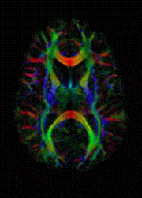
Photo from wikipedia
Background: The mean kurtosis (MK) and fractional anisotropy (FA) in patients of Parkinson’s disease (PD) are usually measured by diffusion kurtosis imaging (DKI) and diffusion tensor imaging (DTI), separately. Methods:… Click to show full abstract
Background: The mean kurtosis (MK) and fractional anisotropy (FA) in patients of Parkinson’s disease (PD) are usually measured by diffusion kurtosis imaging (DKI) and diffusion tensor imaging (DTI), separately. Methods: In this study we perform a meta-analysis to discuss which noninvasive biomarker is more advantageous for PD, MK, or FA. Databases including Medline via PubMed, the Cochrane Central Register of Controlled Trials, Embase via OVID and China National Knowledge Infrastructure. Databases are searched up to December 31st, 2019. Four brain regions are identified for analysis based on data extracted from articles. Results: The articles contain 5 trials with 274 total PD patients and 189 healthy controls (HCs). The results show not only significantly higher MK values of putamen, caudate, globus pallidus in PD compared to that of HCs (weighted mean difference [WMD] = 0.06, 95% CI = 0.02–0.09, P = .002, WMD = 0.03, 95% CI = 0.01–0.067, P = .01, WMD = 0.18, 95% CI = 0.11–0.24, P < .00001), but also a significantly higher FA in caudate of PD compared to HCs (WMD = 0.02, 95% CI = 0.00–0.03, P = .006). Conclusion: This indicates that the sharp difference detected between PD patients and HCs can be detected by DKI and DTI. By further discussing results, we found that MK could be more sensitive diagnostic biomarker than FA toward PD diagnosis.
Journal Title: Medicine
Year Published: 2022
Link to full text (if available)
Share on Social Media: Sign Up to like & get
recommendations!